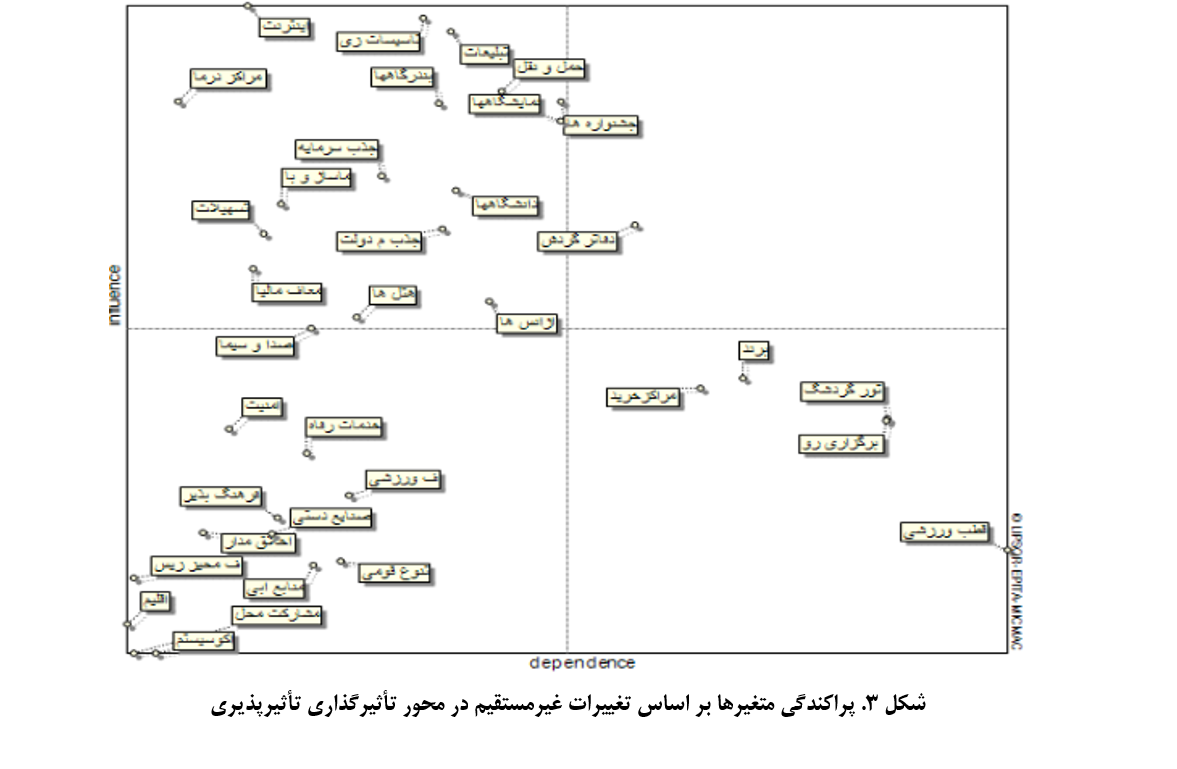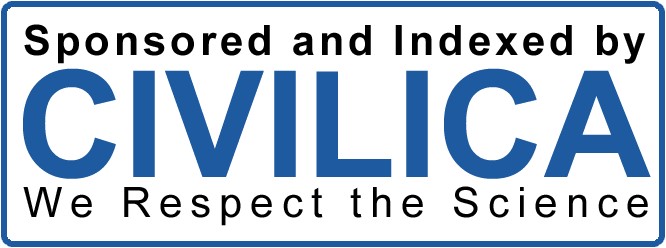Identifying Key Drivers in the Development of Sport Tourism in Aquatic and Beach Sports: A Future Study
Keywords:
Tourism industry, Sport tourism, Cross-impact analysis, CIB, Aquatic and beach sportsAbstract
The present study aimed to identify the key drivers and develop scenarios for enhancing the sport tourism industry in aquatic and beach sports using the Cross-Impact Balance (CIB) analysis method. This applied study adopted an exploratory survey methodology, utilizing a future study and scenario planning approach. The research was conducted in three stages: identifying key indicators through the Delphi method, determining key drivers using MicMac software based on cross-impact analysis, and developing scenarios using Scenario Wizard software rooted in the CIB method. The statistical population included tourism experts, executive professionals, sports and sports management specialists, and urban and regional planning experts. The sample consisted of 30 specialists in urban and regional planning, tourism, and sports management in the first stage, a 14-member expert panel selected purposefully in the second stage, and a focused group of 7 participants in the third stage. The findings identified 14 critical drivers from 35 key factors, including: (1) Internet, (2) Infrastructure facilities, (3) Medical centers, (4) Ports, (5) Public transportation, (6) Sports exhibitions, (7) Private sector investment, (8) Rehabilitation and massage centers, (9) Universities, (10) Facilities, (11) Governmental financial support, (12) Tax exemptions, (13) Hotels and accommodations, and (14) Travel agencies. These factors were recognized as key drivers for developing the sport tourism industry in aquatic and beach sports. In the scenario planning phase, 67% of the scenarios indicated desirability, while 33% reflected stability and crisis within the spatial organization of the tourism industry. The most favorable scenario, Scenario 1, was recommended, emphasizing preservation, drafting, expansion, interaction, development, quantitative and qualitative growth, and improvement of conditions.
Downloads
References
Melo R, Rheenen DV, Sobry C. Sport Tourism Events and Local Sustainable Development: An Overview. 2021:19-
doi: 10.1007/978-3-030-62919-9_2.
Bai Q. Research on the High-Quality Development of Sports Tourism Industry in Guangxi. 2023. doi:
62788/h1vzcov.
Bai X-F, Shin H, Lee S. The Impacts of the Winter Olympic Games on SPORT Tourism: A Systematic Review. JInst. 2021;6(1):39-47. doi: 10.22471/kinesiology.2021.6.1.39.
Blashchak I, Карпа М, Akimova L. Organizational and Management Support of the Sphere of Sports Tourism in
Ukraine: Legal Aspect. Public Administration and Law Review. 2022(3):54-60. doi: 10.36690/2674-5216-2022-3-54.
Boroujerdi SS, Mansouri H, Asadi S. Developing Sports Tourism Destinations in Emerging Countries: The Case of
Zrebar Lake in Iran. Polish Journal of Sport and Tourism. 2023;30(2):22-9. doi: 10.2478/pjst-2023-0010.
Mukhopadhyay K. The Global Concept of Sports Tourism With Emphasis on Indian Perspective. International Journal
for Modern Trends in Science and Technology. 2021(02):23-30. doi: 10.46501/ijmtst0702005.
Dong E, Fan B, Li Y, Jin J, Hu H, Ma Y, et al. Hainan Sport Tourism Development—A SWOT Analysis.
Sustainability. 2022;14(19):12653. doi: 10.3390/su141912653.
Pirjamadi S, Motahhari, Morteza, Karoubi, Mehdi, Mahmoudi, Ahmad. Identifying Marketing Feasibility Indicators
of Sports Tourism Development in Free Trade, Industrial, And Economic Zones in Iran. Tourism Management Studies.
;17(57):47-78. doi: 10.22054/tms.2022.65108.2653.
Morfoulaki M, Myrovali G, Kotoula K-M, Καραγιώργος Θ, Alexandris K. Sport Tourism as Driving Force for
Destinations’ Sustainability. Sustainability. 2023;15(3):2445. doi: 10.3390/su15032445.
Ntelezi AI. Indigenous Games as a Catalyst for Sport Tourism Development in South Africa. International Conference
on Tourism Research. 2024;7(1):453-60. doi: 10.34190/ictr.7.1.2048.
Chen Z. Sustainability Evaluation of Sports Tourism Using a Linguistic Neutrosophic Multi-Criteria Decision-Making
Method. Plos One. 2024;19(3):e0300341. doi: 10.1371/journal.pone.0300341.
Guan Z. The Study for the Analysis of the Development Trend of Sports Tourism. Academic Journal of Science and
Technology. 2024;9(1):263-5. doi: 10.54097/43a49551.
Heebkhoksung K, Rattanawong W, Vongmanee V. A New Paradigm of a Sustainability-Balanced Scorecard Model
for Sport Tourism. Sustainability. 2023;15(13):10586. doi: 10.3390/su151310586.
Sousa DAd, Maguire K. Towards the Development of an Innovative Sustainable Sports Tourism Management
Framework for Portugal. International Conference on Tourism Research. 2022;15(1):593-6. doi: 10.34190/ictr.15.1.375.
Heydari R, Keshtidar M, Ramkissoon H, M E, Asadollahi E. Emerging Industry: Identifying the Effective Institutional
Factors on the Exploitation of Entrepreneurial Opportunities of Sports Tourism Industry in Developing Countries. 2021. doi:
20944/preprints202104.0211.v1.
Heydari R, Keshtidar M, Ramkissoon H, M E, Asadollahi E. Adoption of Entrepreneurial Behaviours in Sports
Tourism in Developing Countries. Highlights of Sustainability. 2022;1(2):41-53. doi: 10.54175/hsustain1020004.
Cheng J. Value and Path Optimization of Multi-Data Fusion Algorithm to Help Sports Tourism High-Quality
Development. Applied Mathematics and Nonlinear Sciences. 2023;9(1). doi: 10.2478/amns.2023.2.00947.
Zhang Y. Information Construction of Sports Tourism in Haikou City Under the Background of Internet. Wireless
Communications and Mobile Computing. 2022;2022:1-11. doi: 10.1155/2022/6171234.
Zhang Y. Analysis on the Development Strategy of Hainan's Sports Tourism Informatization in the Digital Era.
International Journal on Semantic Web and Information Systems. 2023;19(1):1-18. doi: 10.4018/ijswis.325788.
Li C, Lyu S. Machine Learning-Based Classification and Evaluation of Regional Ethnic Traditional Sports Tourism
Resources. Mobile Information Systems. 2022;2022:1-9. doi: 10.1155/2022/8404931.
Kuchumov A, Печерица ЕВ, Gladskaya I, Chaikovskaya A. Sports Tourism in Russia: Essential Aspects and
Development Problems. Bio Web of Conferences. 2021;29:01003. doi: 10.1051/bioconf/20212901003.
Liu Y. Research on the Development Path of Integration of Rural Sports Culture and Sports Tourism in the Context
of Big Data. Applied Mathematics and Nonlinear Sciences. 2023;9(1). doi: 10.2478/amns.2023.1.00150.

Downloads
Published
Submitted
Revised
Accepted
Issue
Section
License
Copyright (c) 2024 Journal of Study and Innovation in Education and Development

This work is licensed under a Creative Commons Attribution-NonCommercial 4.0 International License.










